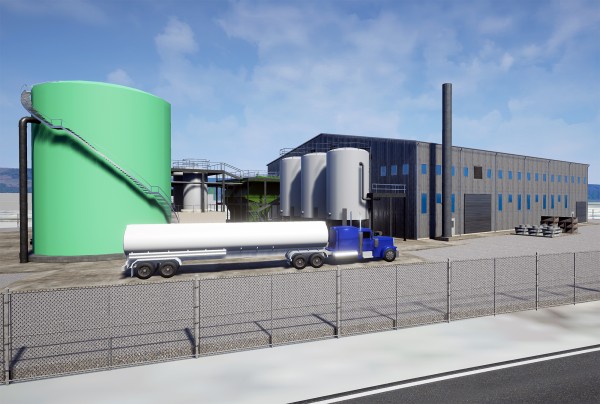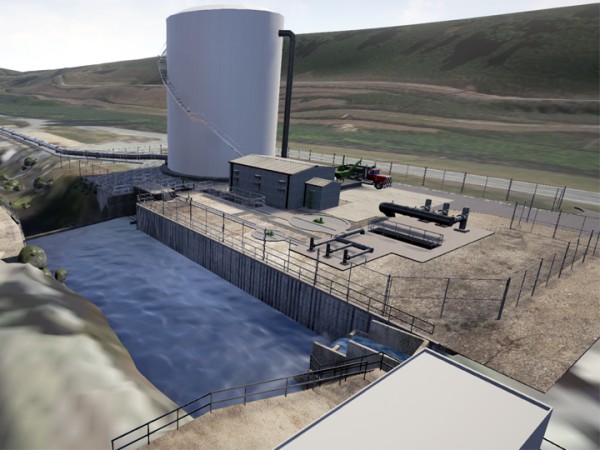
The Mercury Treatment Facility that will be at the east end of Y-12 National Security Complex could start operating in 2022. (Image by David Brown/U.S. Department of Energy)
Note: This story was updated at 2 p.m.
Site preparation could start later this year for the Mercury Treatment Facility at the Y-12 National Security Complex as the U.S. Department of Energy prepares for demolition and cleanup work at the nuclear weapons plant.
DOE’s Oak Ridge Office of Environmental Management, or OREM, expects to complete demolition and cleanup work at the East Tennessee Technology Park, the former K-25 site, in 2020. It will then focus on the large-scale demolition work at Y-12.
Among the Y-12 buildings that could be demolished are Alpha 4, Alpha 5, and Beta 4, all large buildings where mercury, a toxic metal, was once used. The buildings used mercury to separate lithium for nuclear weapons. The lithium separation operations started in 1955 and ended in 1963.
But before that cleanup work can begin, OREMÂ needs the Mercury Treatment Facility. The plant was first announced at a press conference featuring U.S. Senator Lamar Alexander, a Tennessee Republican, about four years ago, in May 2013.
“This water treatment plant is a major step in addressing one of the biggest problems we have from the Cold War era—mercury once used to make nuclear weapons getting into our waterways,†Alexander said at the time.
Earlier this month, Jay Mullis, acting manager of the Oak Ridge Office of Environmental Management, said large-scale construction on the treatment plant could start in 2018, and it could begin operating in 2022. A video posted online by the DOE Oak Ridge Office said the plant is expected to reduce the mercury concentration in water leaving Y-12 through Upper East Fork Poplar Creek by 84 percent.
The Mercury Treatment Facility will have two parts. One is known as the Headworks Facility. It will be at Outfall 200 at Y-12. That’s where mercury contamination that originates in the West End Mercury Area at Y-12 enters Upper East Fork Poplar Creek after flowing through storm drains.
The second part of the plant, the Mercury Treatment Facility itself, will be on the east end of Y-12.
Mercury migrating from the mercury-contaminated area on the west end of Y-12 will enter the headworks facility at Outfall 200 and flow through piping to the Mercury Treatment Facility, where it will be treated. The treated water will then be fed into Upper East Fork Poplar Creek, which flows north out of Y-12 into central Oak Ridge.
Once the plant begins operating, OREM can start removing the large contaminated buildings at Y-12 and address the mercury in the soil and groundwater beneath, DOE said.
Officials said the mercury travels from west to east at Y-12, and the new plant will allow a large percentage of mercury to be captured before it travels off the site and into the environment.
The precise cost of the plant isn’t clear, but preliminary estimates have said it could range from $150 million to $300 million, Mullis said. The estimate could be refined later.
The Mercury Treatment Facility is one part of the next major phase of cleanup at the three federal sites in Oak Ridge that were built to help build atomic weapons during World War II as part of the top-secret Manhattan Project. The three sites—K-25 (now ETTP or Heritage Center), Y-12, and X-10 (now Oak Ridge National Laboratory)—had other missions after the war as well, although the K-25 site was shut down about three decades ago and is slowly being converted into an industrial park.
Other major steps in the cleanup process are to build the Environmental Management Disposal Facility, possibly west of Y-12, for onsite waste disposal from cleanup work at Y-12 and ORNL, and preparing more facilities for future demolition under the Excess Facilities Initiative.
In the video posted online, the DOE Oak Ridge Office said the need for the Mercury Treatment Facility at Y-12 dates back to the nuclear weapons work at Y-12 in the 1950s and 1960s, when the plant used more than 20 million pounds of mercury. During that time, about 700,000 pounds of mercury were lost into buildings, soil, groundwater, and sediment.
When the soils and buildings have been disturbed in the past, they’ve released mercury, Mullis said during an April 12 annual community budget workshop.
The new Mercury Treatment Facility will help capture mercury that migrates from the buildings and soil when major demolition starts at Y-12. The treatment facility will also help DOE meet regulatory limits, DOE said in the online video.
The plant is being designed to treat up to 3,000 gallons per minute. It will also have a two-million-gallon storage tank for stormwater. A modular design will allow future modifications for more stormwater storage or operations that could allow more mercury reductions.
During the April 12 workshop, Mullis said the design for the Mercury Treatment Facility was completed a few months earlier by cleanup contractor UCOR and its contractor, and there was a department review a few weeks before the April 12 meeting. The design is now in a comments phase, with a final report possible in three to four weeks, Mullis said in mid-April.
The new water treatment plant will be on the south side of Y-12’s main production area, and officials expect to tear down another contaminated building, Alpha 2, as part of the cleanup work.
In 2013, Mark Whitney, who was then environmental management manager in the U.S. Department of Energy’s Oak Ridge Office, said mercury contamination at Y-12 is the greatest environmental risk on the Oak Ridge Reservation. He said remediation work began in the 1980s, and federal officials used about $250 million from the American Recovery and Reinvestment Act of 2009 on the work and to help design the new water treatment plant.
Sue Cange, who was then deputy environmental management manager in the Oak Ridge Office, said the amount of mercury that flows into East Fork Poplar Creek varies, but the waterway generally has a concentration of about 400 parts per trillion. State water quality criteria call for a concentration of 51 parts per trillion or less, she said. It’s not clear if the water concentration has changed since then, and if so, by how much.
East Fork Poplar Creek starts at a spring at the Y-12 National Security Complex and flows through Oak Ridge before joining West Fork Poplar Creek at the former K-25 site, now known as East Tennessee Technology Park. It has been listed on a state list of impaired waterways due to mercury and polychlorinated biphenyls, among other concerns.
ICYMI: New facility will pave the way for major demolition and cleanup at @y12nsc. https://t.co/4BPP6WCJPD
— DOE Oak Ridge Office (@OakRidgeOffice) February 14, 2017

The Mercury Treatment Facility that will be at the east end of Y-12 National Security Complex could start operating in 2022. (Image by David Brown/U.S. Department of Energy)

The Headworks Facility that will be at Outfall 200 as part of the Mercury Treatment Facility that could start operating at the Y-12 National Security Complex in 2022. (Image by David Brown/U.S. Department of Energy)

The Headworks Facility that will be at Outfall 200 as part of the Mercury Treatment Facility that could start operating at the Y-12 National Security Complex in 2022. (Image by David Brown/U.S. Department of Energy)
See previous stories here:
- Construction on Y-12 mercury treatment plant could start in 2018, cost $146 million
- Cleanup work shifts to mercury as new Y-12 water treatment plant announced
More information will be added as it becomes available.
Do you appreciate this story or our work in general? If so, please consider a monthly subscription to Oak Ridge Today. See our Subscribe page here. Thank you for reading Oak Ridge Today.
Copyright 2017 Oak Ridge Today. All rights reserved. This material may not be published, broadcast, rewritten, or redistributed.





Leave a Reply